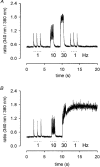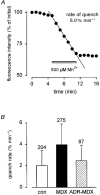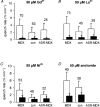Increased calcium entry into dystrophin-deficient muscle fibres of MDX and ADR-MDX mice is reduced by ion channel blockers
- PMID: 10066910
- PMCID: PMC2269189
- DOI: 10.1111/j.1469-7793.1999.859ab.x
Increased calcium entry into dystrophin-deficient muscle fibres of MDX and ADR-MDX mice is reduced by ion channel blockers
Abstract
1. Single fibres were enzymatically isolated from interosseus muscles of dystrophic MDX mice, myotonic-dystrophic double mutant ADR-MDX mice and C57BL/10 controls. The fibres were kept in cell culture for up to 2 weeks for the study of Ca2+ homeostasis and sarcolemmal Ca2+ permeability. 2. Resting levels of intracellular free Ca2+, determined with the fluorescent Ca2+ indicator fura-2, were slightly higher in MDX (63 +/- 20 nM; means +/- s.d.; n = 454 analysed fibres) and ADR-MDX (65 +/- 12 nM; n = 87) fibres than in controls (51 +/- 20 nM; n = 265). 3. The amplitudes of electrically induced Ca2+ transients did not differ between MDX fibres and controls. Decay time constants of Ca2+ transients ranged between 10 and 55 ms in both genotypes. In 50 % of MDX fibres (n = 68), but in only 20 % of controls (n = 54), the decay time constants were > 35 ms. 4. Bath application of Mn2+ resulted in a progressive quench of fura-2 fluorescence emitted from the fibres. The quench rate was about 2 times higher in MDX fibres (3.98 +/- 1.9 % min-1; n = 275) than in controls (2.03 +/- 1.4 % min-1; n = 204). The quench rate in ADR-MDX fibres (2.49 +/- 1.4 % min-1; n = 87) was closer to that of controls. 5. The Mn2+ influx into MDX fibres was reduced to 10 % by Gd3+, to 19 % by La3+ and to 47 % by Ni2+ (all at 50 microM). Bath application of 50 microM amiloride inhibited the Mn2+ influx to 37 %. 6. We conclude that in isolated, resting MDX muscle fibres the membrane permeability for divalent cations is increased. The presumed additional influx of Ca2+ occurs through ion channels, but is well compensated for by effective cellular Ca2+ transport systems. The milder dystrophic phenotype of ADR-MDX mice is correlated with a smaller increase of their sarcolemmal Ca2+ permeability.
Figures






 ) fibres.
) fibres.


References
-
- Bakker AJ, Head SI, Stephenson DG. Time course of calcium transients derived from Fura-2 fluorescence measurements in single fast twitch fibres of adult mice and rat myotubes developing in primary culture. Cell Calcium. 1997;21:359–364. - PubMed
-
- Brenman JE, Chao DS, Gee SH, McGee AW, Craven SE, Santillano DR, Wu Z, Huang F, Xia H, Peters MF, Froehner SC, Bredt DS. Interaction of nitric oxide synthase with the postsynaptic density protein PSD-95 and α1-syntrophin mediated by PDZ domains. Cell. 1996;84:757–767. - PubMed
-
- Collatz MB, Rüdel R, Brinkmeier H. The intracellular calcium chelator BAPTA protects cells against toxic calcium overload but also alters physiological calcium responses. Cell Calcium. 1997;21:453–459. - PubMed
Publication types
MeSH terms
Substances
LinkOut - more resources
Full Text Sources
Other Literature Sources
Research Materials
Miscellaneous

